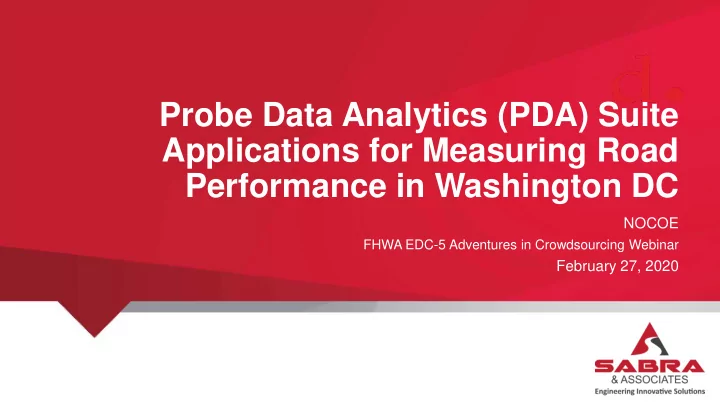

Probe Data Analytics (PDA) Suite Applications for Measuring Road Performance in Washington DC NOCOE FHWA EDC-5 Adventures in Crowdsourcing Webinar February 27, 2020
Agenda Background/ Data Practical Future Questions Opportunities Motivation Sources Applications 2
Background Citywide Signal Optimization How do we efficiently evaluate benefits for all roadway users? Quick Response to Citizen Concerns Major Special Events How to predict, mitigate and monitor? How good is the data? 3
Motivation What data is available? How are we using it? What have we learned along the way? Where do we go from here? 4 4
Data Sources RITIS - INRIX Live System Status Historical Data/PDA Suite WMATA AVL Google Traffic Live/Typical Waze Floating Car/GPS Bicycle Travel Time CCTV 5
Practical Applications Downtown Optimization 600+ Signal Grid Network Overnight Implementation Cars, Buses, Peds, Bikes 49 Travel Time Routes 40+ Bus Routes 1,500+ Signalized Crosswalks 7,000+ Cycle Trips per Day 6
Downtown Results – Vehicle Probe Project (VPP) Travel Time Travel Time for NB 12 th Street Between Pennsylvania Avenue and Massachusetts Avenue Travel Time Savings noted during ‘after’ AM, Midday and PM period 7
Downtown Results – VPP Travel Time as CDFs Rhode Island Avenue Travel Time Cumulative Distribution • CDFs provide a visual 100% representation of travel 90% 80% time reliability Cumulative % of Samples 70% • Possible since PDA Suite 60% provides many travel time 50% data points 40% 30% • With traditional floating car 20% data (~6 runs per corridor) 10% this is not possible 0% 8 11 14 17 Travel Time (minutes) Before After 8
Downtown Results – VPP Travel Times Mapped 9
Downtown Results – VPP Congestion Significantly reduced queuing and increased speeds noted during ‘after’ AM, Midday and PM period 10
Citizen Requests – Rapid Before/After Evaluations • Early March 2017 Report from citizen of congestion along Michigan Avenue during AM Not optimized since 2005; • network optimization scheduled for Fall 2017 • Quickly reviewed and updated timings for 4 intersections • Achieved approximately 2 minute travel time improvement on 1.3 mile corridor • Extremely low cost improvement & minimal before/after data collection cost to demonstrate benefits 11
Citizen Requests – Rapid Validation What happened? Citizens note increase in Checked RITIS incident congestion/travel time data on a Wednesday Checked RITIS construction data Field Observations Checked signal timing performed on following data Tuesday show typical Checked signal trouble calls conditions. Checked for special So, what happened? events in the area Etc. RITIS can tell us that something happened but not necessarily why or what. 12
Citizen Requests – Rapid Validation Before Phase Conversion Citizens note increase in congestion/travel after Phase Conversion • Used RITIS data to validate the concern • Resolved, and then rechecked the data 13
Analysis Results – User Costs PDA Suite User Delay Cost Tool Synchro-based Intersection Delay Considered mainline traffic only Considered all traffic approaches US 1 (Rhode US 1 (Rhode Delay Delay Costs Island Ave) Island Ave) (hours) Average Day $41,797 772,900 “Before” Before Average Day $32,116 “After” 556,880 After $9,681 (23%) Daily Savings 216,020 (28%) Daily Benefit Annual $2,420,250 $5,839,021 Annual Benefit Savings 14
Papal Visit - Background Sabra & Associates notified of need for traffic analysis and operations services 22 business 2015 Papal Visit to DC (Pope Francis) September 22 nd through September days before arrival: 24 th , 2015 Microsimulation of entire network for upper management Report identifying impacts within 7 days Possible detour/alternate routes Signal re-timing/mitigation Traffic Control Officer (TCO) deployment Variable Message Sign (VMS) locations 15
Papal Visit – Impact Analysis Approximate Existing queues on major routes Ramp to E Street • RITIS/INRIX/Google to observe Expressway typical maximum queue lengths • Estimate typical bottleneck capacity 23 rd Street • Estimate typical jam density • Identify closure-induced bottleneck location and estimate capacity Roosevelt Bridge • Calculate maximum static queue length Constitution Avenue 16
Papal Visit – Impact Analysis Validation Historical Unplanned Closure of 14 th Street incident Anticipated Impacts due to 14 th Street Closure 17
Papal Visit – Mitigation Measures 18
Papal Visit – Mitigation Measures 19
Papal Visit - Outcomes 20
Papal Visit - Outcomes RITIS Comparison Tweeted by MATOC 21
Data Quality – How good is it? Like any other tool – you need to know how and when to use it! • Baltimore City PDA Data Quality: Inrix CumTT 2/6/2019 8:45 Here CumTT 1400 1200 1000 800 600 400 200 0 1 2 3 4 5 6 7 8 9 10 11 22
Data Quality – How good is it? Like any other tool – you need to know how and when to use it! • Long-term analysis: I-95 Corridor Coalition Validation of Arterial Probe Data Report (2015): Probe data consistently errored toward faster speeds during congested periods. The extent of slowdown measured in terms of reduction in speed was consistently underestimated as evidence by SEB measurements as well as by the distribution analysis. Even for events classified as fully captured, any error in the extent of slowdown was biased toward faster speeds. This systematic bias towards higher speeds will have programmatic significance if probe data is used in long term performance monitoring . As probe data quality improves, the data will more accurately report the full extent of slowdowns. As a result congestion may appear to grow worse when in actuality, it is only the quality of the probe data that is improving . This scenario has been corroborated by early adopters of probe data for arterial performance measures. 23
Where do we go from here? Heavier reliance on PDA Suite travel time data for analysis Bluetooth/WiFi/TPMS travel time data when PDA data is poor (e.g. Baltimore City) Field-collected travel time data for validation Heavier use of Transit AVL data for TSP and Signal Optimization evaluation Leverage available Bike data from bike-share services? Pedestrians? Crowdsourced GPS? 24
Thank You
Recommend
More recommend